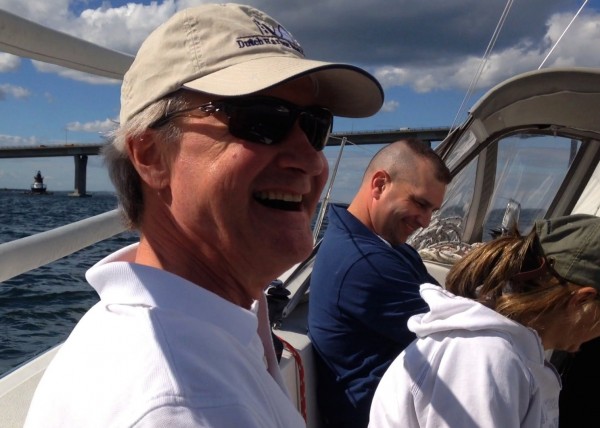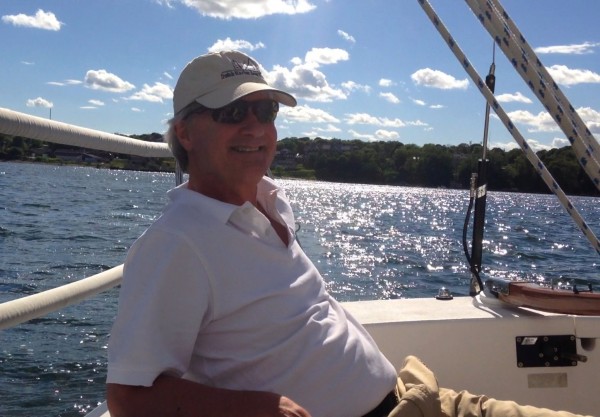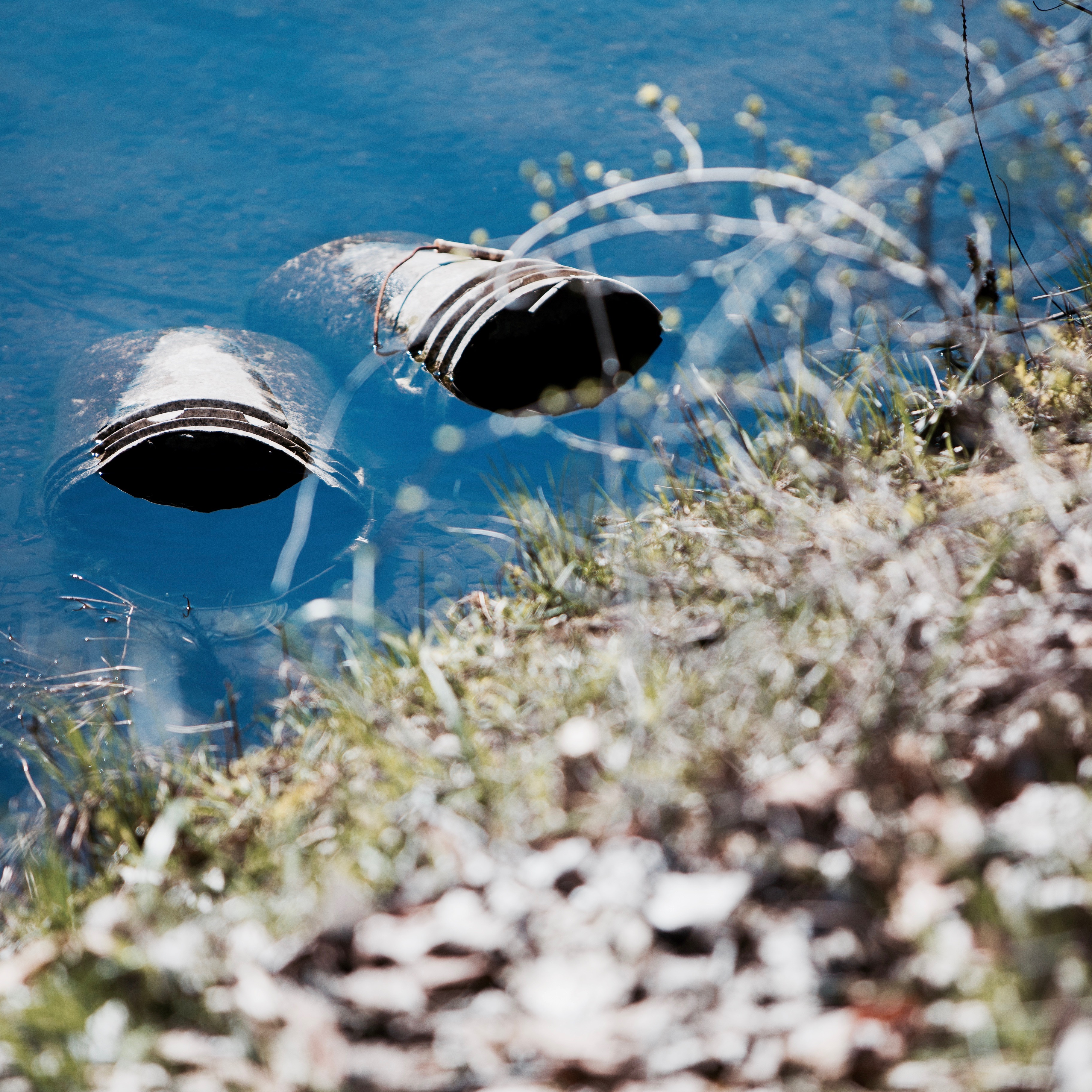
Conservation Law Foundation (CLF) argued Tuesday before the United States District Court for the District of Rhode Island concerning the failure of the U.S. Environmental Protection Agency (EPA) to adequately protect Rhode Island waterbodies from ongoing and devastating stormwater pollution. Despite determinations from EPA and Rhode Island’s Department of Environmental Management (DEM) that Mashapaug Pond, Bailey’s Brook, North Easton Pond, and other nearby waters are seriously harmed by runoff from surrounding commercial and industrial properties, EPA failed to require dischargers to obtain the necessary permits under the federal Clean Water Act.
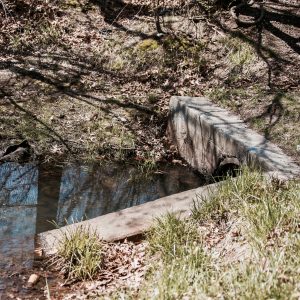
“One of the great sources of pride for Rhode Island – the Ocean State – ought to be our ponds, rivers and beautiful coastline, but decades of toxic runoff has imperiled our waters, closed our beaches and endangered important wildlife habitats,” said CLF attorney Max Greene. “There’s no question that nasty pollutants like nitrogen and phosphorus, the precursors to toxic algae blooms, are constantly flowing from industrial campuses and commercial shopping centers into nearby waterways, yet EPA has sat on its hands rather than take the legally-required steps to address this rampant contamination. Today, EPA was forced to answer for that neglect in federal court, and we’re optimistic that Rhode Island waters will soon be on the path to recovery.”
Today’s hearing comes on the heels of an announcement from Rhode Island DEM earlier this month that lower Narragansett Bay, lower Sakonnet River, and a portion of Rhode Island Sound are being closed due to toxic shellfish findings associated with harmful algae blooms.
For more information on CLF’s fight to protect Rhode Island from stormwater runoff, please see CLF’s white paper on the issue, “Closing the Clean Water Gap: Protecting our Waterways by Making All Polluters Pay.”
A copy of CLF’s filing can be read here, and photos of the endangered Mashapaug Pond can be seen here.

]]>
 When the Providence Police Department, the Woonasquatucket River Greenway Project, the Olneyville Housing Corporation, and the community joined forces, it was all for the love of a river. The banks of the Woonasquatucket were strewn with trash, the soil was toxic from the mill industry of a bygone era, the underused and overgrown area was a perfect invitation for drug deals and other nefarious activity.
When the Providence Police Department, the Woonasquatucket River Greenway Project, the Olneyville Housing Corporation, and the community joined forces, it was all for the love of a river. The banks of the Woonasquatucket were strewn with trash, the soil was toxic from the mill industry of a bygone era, the underused and overgrown area was a perfect invitation for drug deals and other nefarious activity.
And the children of this community, which is rich with diversity and hardworking folks trying to provide safe recreational opportunities for youth, were getting the short end of the environmental stick. It isn’t an unusual situation. But truth be told, kids and adults everywhere love nature whether in cities, suburbs or the country, whether poor or well-to-do if given an opportunity to revel in its beauty.
When the Woonasquatucket restoration began, everyone knew it was not going to be an easy job. But the benefits of the eventual payoff provided a strong incentive.
The scene then wasn’t pretty, and the work ahead was hard. The area needed to be rid of highly contaminated soil, a toxic legacy of the industrial past, new soil put in, and old soil capped to prevent exposure to lingering pollutants. The area was strewn with trash and debris that required removal by heavy manual labor.
Plantings of trees, shrubs and gardens went on unnoticed at first, until a local community group took root and started a bike shop next to a blooming community garden. All of these were small but critical steps to returning health to the river and the surrounding community.
These actions were informed by the broken window theory, which proposes that lower levels of disorder in a community lead to higher and higher levels of disorder.
Trash signals a lack of concern for residents and leads to degraded care for property, which leads to greater levels of devaluing the community and higher-level crimes. Olneyville was an example of this theory in action. Through it all ran the Woonasquatucket River, a forgotten treasure that once attracted the Huck Finn in all of us.
Once community-minded partners got together and restored the riverbanks as a haven for recreation, there arrived a burgeoning volunteer force ready to maintain it. Over 1,300 volunteers many of them local residents lent a helping hand last year alone. Today, there are bike programs, educational activities, art competitions, and Riverside Park. The area once buried beneath pollution and crime is an intergenerational gathering point for healthy play, conversation and relaxation. Criminal activity has dropped sharply and the community, its housing and environmental agencies, and the police are partners in an urban success story where a winding river now flows past peaceful banks on its way to Narragansett Bay.
The success of the Woonasquatucket River and neighborhood restoration project was featured in the recently released 2016 Watershed Counts Report, an annual update on the health of the bi-state Narragansett Bay Watershed that guides future actions. This case study focused on how the collaborative work of individuals, communities, private organizations, and state and federal authorities is critical to the protection of Narragansett Bay, one of New England’s greatest natural and economic resources.
Clean environments that support the love of nature are ubiquitous among people of every background, and should be central to uplifting efforts as dedicated citizens, advocacy groups and local governments work with communities seeking to calm troubled waters throughout the nation.
]]>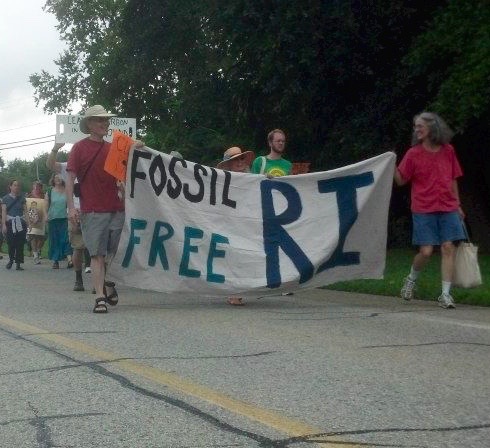 At its public meeting today, the Rhode Island Energy Facility Siting Board postponed ruling on giving grassroots groups and individuals the opportunity to get a fair hearing of their objections to the Clear River Energy Center, a fracked-gas power plant proposed by Invenergy, based in Chicago, IL. The board will announce its final ruling on this matter at the next public hearing, scheduled for January 29.
At its public meeting today, the Rhode Island Energy Facility Siting Board postponed ruling on giving grassroots groups and individuals the opportunity to get a fair hearing of their objections to the Clear River Energy Center, a fracked-gas power plant proposed by Invenergy, based in Chicago, IL. The board will announce its final ruling on this matter at the next public hearing, scheduled for January 29.
The two remaining members of the three who should make up the board serve at the pleasure of Governor Raimondo, who is on record supporting expansion of the “natural” gas infrastructure. As a result, Janet Coit, one of the two board members, is in a bind. She is Director of the Rhode Island Department of Environmental Management and an avid environmentalist. Last summer, she spoke at the Sierra Club-sponsored rally, “The Environment is Everyone’s Business.” Coit is painfully aware of the toll climate change is already taking on life in Narragansett Bay. At the rally, she referred to a “profound experience” she had looking at colonial nesting birds on Hope Island. She said: “There are several islands in the Bay that used to host colonies of nesting terns and now they are submerged.”
Said Lisa Petrie of Fossil Free Rhode Island: “We’re calling on Governor Raimondo to wake up and recognize that building more gas-fired power plants threatens the future of our state and of humanity as a whole.” Indeed, the Invenergy proposal is inconsistent with the U.S. Environmental Protection Agency’s 2009 Endangerment Finding, which determined that greenhouse gas emissions endanger public health and welfare of current and future generations. This language parallels that of the 2007 denial of a fossil-fuel plant permit by Roderick Brembly, Secretary of the Kansas Department of Health and Environment. Obviously, team Raimondo is lagging reality by almost a decade.
Fossil Free Rhode Island reiterated that Governor Raimondo’s policies violate Article 1, Section 17 of the Rhode Island Constitution, the supreme law of the state, which clearly specifies the duty “to provide for the conservation of the air, land, water, plant, animal, mineral and other natural resources of the state.”
The Conservation Law Foundation has put forth that, by increasing Rhode Island’s greenhouse gas emissions, the Clear River Energy Center would violate the Resilient Rhode Island Act of 2014. The foundation urged the Board to terminate its deliberations, which would effectively deny Invenergy the permit it seeks.
The Burrillville Land Trust, in a blistering take down of Invenergy’s proposal, argued for the same and writes: “We are being denied an opportunity to respond in a meaningful way because of mis-information, inadequate information and outright absence of information.”
Governor Raimondo has tried to make the case that Invenergy’s Energy Center will bring jobs to Rhode Island. The Rhode Island Building and Construction Trades Council, in its request for late intervention, agrees with the governor. This view is untenable and Fossil Free Rhode Island referred to a recent report of the Political Economy Research Institute of UMass in Amherst that states: “New investments in energy efficiency and renewable energy will generate more jobs for a given amount of spending than maintaining or expanding each country’s existing fossil fuel sectors.”
Fossil Free Rhode Island once again drew attention to current research that shows that, given the urgency of dealing with climate change, “natural” gas has a larger greenhouse gas footprint than coal and oil. In other words, Invenergy’s proposed power plant is bad for Rhode Island on all counts: physics, economics and morality.
Sister Mary Pendergast, one of the individual intervenors, said: “I do not think that the spiritual and moral issues of environmental ethics will be adequately represented by excluding my testimony. Any decision the Siting Board makes that is good for the corporation, but not for the environment, is a bad decision and we will live to regret it.”
The Board referred to the ambiguous rules under which they operate. They seem to interpret the rules as the requirement of attorney representation. This interpretation would exclude virtually all members of the public who filed for the status of intervenor. Pat Fontes, representing Occupy Providence, said: “The refusal to admit the voice of Occupy Providence in the deliberations of this board would symbolize and contribute to the likelihood that ‘government of the people, by the people, and for the people’ will indeed perish from the earth.”
[From a press release]
RI Future covered the hearing here: Strong public opposition to Burrillville power plant at hearing
]]>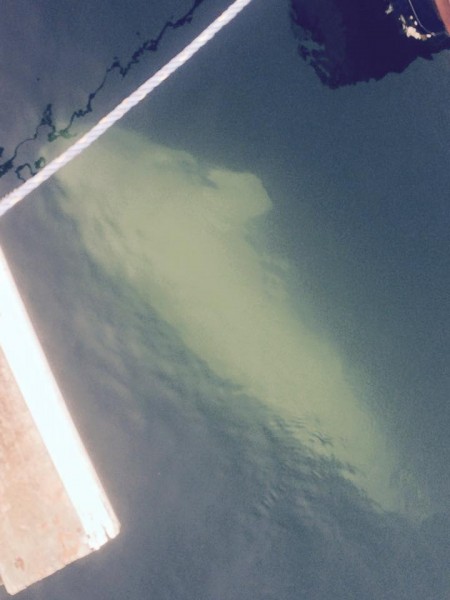
How rare of a marine mammal sighting are the beluga whales that have been spotted at various locations in Narragansett Bay on Sunday and Monday?
“It’s the second one ever in Rhode Island,” said Bob Kenney, an oceanography professor at the URI Bay Campus who studies whales and wrote this about belugas.
“The first one was last year,” he added.
In July, 2014, a fisherman spotted and videoed a lone beluga whale in the West Passage between Jamestown and Saunderstown. At roughly the same time, a second beluga whale was seen in the Taunton River near Fall River last year.
Then on Sunday, David DeSalvo and Matt King videoed three beluga whales north of the Newport Bridge and just off the eastern shore of Jamestown. DeSalvo estimated they were about 12 to 15 feet long.
On Monday morning, the RI Department of Environmental Management fielded reports that the three beluga whales were seen further north up Narragansett Bay off Rocky Point in Warwick. A team from DEM and Mystic Aquarium dispatched a 22-ft research boat, crewed by two biologists and a veterinarian, to ensure the mammals are healthy on Monday. They appeared healthy in the video, said April Valliere, a supervising biologist who studies marine mammals with DEM.
She said increasingly colder waters in southern New England may be enticing beluga whales from their native habitat of the St. Lawrence Seaway in northeastern North America.
“I suspect cooler water temperatures have something to do with it,” she told me. “It’s off several degrees. It’s still in the 40’s outside the Bay.”
But she said scientists really don’t know yet. “We’re not really sure. Obviously there is food for them,” she said, noting that squid and menhaden are now running in Narragansett Bay.
There’s a theory that the heavily-polluted St. Lawrence may be causing cancer in beluga whales. Perhaps the pearl white whales are relocating to a cleaner habitat? In a Providence Journal op/ed last year, Mystic Aquarium President Steven Coan said a changing climate is opening up new southern habitat to beluga whales. “The sight of a Beluga in southern New England is rare and unusual today but could quickly become a more frequent occurrence. Climate change is affecting our seas and the creatures that live in them. In some cases the natural food supply for a certain species may shift location, moving to a warmer or cooler spot in the ocean.
Beluga whales aren’t the only whales that visit Narragansett Bay. Minkie whales frequent the lower Bay as does the occasional fin whale in the winter. Several species of whales live in or pass through the Rhode Island and Block Island sounds, the parts of the Atlantic off the coast of Rhode Island.
Whales are protected by the Marine Mammal Protection Act, and as such it’s a felony to disturb them. Boaters, Kenney and Valliere both stressed, should take extreme caution.
“Anything a boater does that disturbs teir natural behaviors is a violation of federal law, you could go to jail for up to two years” Kenney said. “The best thing to do is shut the engine down and watch them. They may just come close. But don’t chase them.”
]]>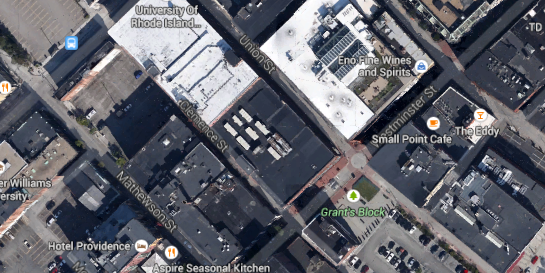 Central Falls, Cranston, East Providence, North Providence, Pawtucket, Providence, and Warwick belong to the upper Narragansett Bay watershed. All of these communities except North Providence have been cooperating in studies of how to prevent stormwater overflow in the region. Phase I of the study is already complete, and Phase II is being worked on. Phase I essentially explores the problem, while Phase II will look into proactive solutions.
Central Falls, Cranston, East Providence, North Providence, Pawtucket, Providence, and Warwick belong to the upper Narragansett Bay watershed. All of these communities except North Providence have been cooperating in studies of how to prevent stormwater overflow in the region. Phase I of the study is already complete, and Phase II is being worked on. Phase I essentially explores the problem, while Phase II will look into proactive solutions.
The problem, summarized briefly, is that the more impermeable surfaces the region has, the more of our fecal matter goes into the bay when it rains. The plan is to think strategically as a region about how to address the amount of impermeable surfaces we have.
A stormwater management district will assess some kind of fee, usually in people’s water bill, according to what kind of impermeable surfaces the user has. Ratepayers will be able to get credits for improvements to their properties that fix their stormwater issues. Assigning appropriate fees and credits is paramount.
But impervious surfaces aren’t all equally bad.
None the less, frequently advocates have turned to a measure of success based on the percentage of land that is impermeable, with the target percentage being under 10 percent. Percentages hide more than they show:
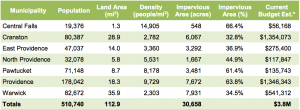
Percentages lie
The highest percentage of impermeable surfaces in the region is in Central Falls, at 66.4%. Providence and Pawtucket are close behind. By contrast, suburban areas like Cranston, East Providence, and Warwick look to have half as much impermeable surface percentage covered.
If you look at the absolute surface area that is covered, it’s clear that Central Falls has the least area that is impervious. In a way this is common sense, because Central Falls is small, but the intuitive thinking about protecting water from overflow pollution is that a lower percentage is better. A really stark illustration of this is in the contrast between Warwick and Providence, for instance. Providence is almost twice as impervious as Warwick by percentage, but by absolute area the two are about equal!
Absolute numbers aren’t even giving the full picture.
If you go deeper still, you see that the per person impervious area is very small in the dense cities, and very high in the suburbs. Each of the 19,378 Central Falls residents has about three-hundredths of an acre of impervious surface to their name. In Warwick, it’s almost a full tenth of an acre per person, about three times as much per capita.
Not all impermeable surfaces are equal
Not every square foot of impermeability is equal, and a future stormwater district should not treat them as such. These images are roughly to scale (100 ft level on Google Maps). The top image is part of Warwick Mall, and the bottom one is part of Downcity, Providence. It’s really a toss-up as to which one has more impermeable surfaces. I might be inclined to guess that Providence has slightly less green space in this shot. It’s a clincher. But it’s very clear which neighborhood is making productive use of land.
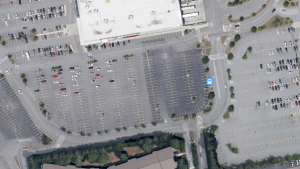
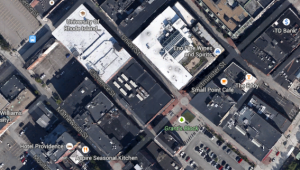
Incentivizing behavior
Phase II of the study, which is not yet completed, will look at solutions. We should be on top of this process to make sure that it incentivizes the right behavior, instead of green-washing the problem.
The Providence image shows that past errors have led to some knocked out teeth in the downtown, now as “temporary” surface lots. A stormwater district should make it clear that it is a positive benefit to the community to redevelop a surface lot into a building, even if the exact same impermeable surface remains. Surface lots don’t just create their own individual problems, but are the lead on land use and transportation misalignments across the board. When there’s a lot of parking, fewer people can live in downtown, and more people will need to drive, leading to wider roads.
The only policy measure floated about parking in the report is about using more permeable surfaces for lots (Central Falls already does this at its Ledge Street municipal lot). On page 87-88, the report states:
It is not enough to simply provide funding for the stormwater program, property owners need to help manage stormwater on-site, at the point it is generated. For example, roof runoff can be directed to a dry well on the property, and depending on the size, parking lot runoff can also be “disconnected” by draining to a lawn area, rain garden or other on-site infiltration or treatment system. Improvements made by property owners reduce the volume of runoff that must be managed by the town and thus reduce the town’s overall stormwater program costs.
To me, this line is like trying to trot out the best new fashions in colostomy bags in lieu of offering preventative measures against colon cancer. Why would we make deeper investments into unproductive land uses in order to deal with a surface symptom of the problems they cause?
The surface lot in the image of the Warwick Mall, which is only a tiny piece of the much larger lot, is not something to be tweaked with an underground treatment system. Of course, kudos on making the owner of such a lot pay for the system him/herself, because it’s much better than having ratepayers see increases in their water bills. But the true solution we should be pushing for is recognizing the cancer of surface parking as what it is so that we can root it out.
Houston, we have a problem
We should look to our past mistakes with stormwater management to make sure we don’t repeat them. Houston is a stunning reminder that not all impermeable surfaces are the same. Houston had a huge stormwater pollution problem, which the EPA approached by disallowing new stresses to the sewer system (i.e., buildings with sewer connections) unless other stresses (other buildings) were removed. Houston developers replied to this well-intentioned regulation by tearing out neighborhoods and replacing them with towers in glimmering fields of asphalt parking lots. The problem remains to this day, and Houston’s downtown would make Warwick Mall blush.
The problem is discussed at some length in this Streetfilms video on parking craters.
Parking Craters: Scourge of American Downtowns from STREETFILMS on Vimeo.
The approach we take needs to understand that parking and wide roads are some of the biggest and most wasteful public liabilities we have, and that rooftops, though impermeable, are not. A surface lot induces more impermeable surfaces and gives the community nothing in return. A building helps to reduce the need for other surfaces, like roads or lots, by adding density, and gives the community economic development that it can use to eventually pay for even greater improvements, like street trees or green roofs.
This is not an idle point. I’ve only had informal conversations with Providence officials about this, but those officials have expressed a kind of quiet embarrassment about what they see as the city’s being behind on stormwater, and needing to catch up to Warwick and Cranston. With this attitude in hand, I’m concerned about what might result.
We need to make sure that those who are writing a stormwater management system do not blame urban areas by misusing the data, and focusing on percentages of impermeable surfaces. The absolute surface area and the per capita area are far more important. Under this analysis, areas like Central Falls are giving the state a credit through their lifestyle everyday, while residents in Warwick are detracting from the health of the state. The fee system set up for stormwater management should reflect this.
~~~~
Small correction: The Streetfilms video mentions Dallas, not Houston. Although, truth be told, Houston does in fact have the same problem. See for example this post from the Final Four competition at Streetfilms’ sister site, Streetsblog. In any case, the point is that we definitely don’t want to follow Texas in anything land use related. It’s a bad scene all around, and we can do better.
]]>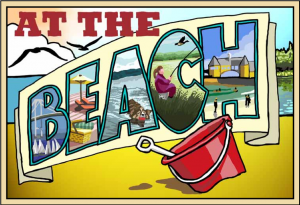
It was Governor’s Bay Day this past weekend, where the bonus was free parking and free transportation to the state beaches in Narragansett Bay and along the Atlantic coast, widely acclaimed as some of the most beautiful shoreline in the world. Beaches are not normally free as user fees help maintain and protect these valuable natural assets.
Over the last several years, many towns like Bristol and Newport have invested millions in infrastructure to protect Bristol Town Beach, Easton’s (First) Beach in Newport, and other local beaches. These improvements come at a cost, but they are critical long-term investments to help keep beaches open and avoid costly beach closures. When beaches are open, local economies that rely upon beachgoers and tourists reap measurable returns. Visitors that enjoy these clean beaches also return to enjoy future beach seasons. A new report by Watershed Counts was issued this week that celebrates these investments to protect water quality at our beaches, and gives the public a full assessment of their current health.
The 2014 Watershed Counts Report [RI Future story here] details how the summer of 2013 saw impressive rain totals. Normally, a pattern of excessive rain translates into a large number of beaches closures. This is because rain washes pollution and bacteria into our coastal waters and beaches must be closed by the health departments to protect people from disease. But 2013 was different for those towns that had the foresight and financial backbone to tackle these issues. Newport invested over $6 million to build an ultraviolet plant to disinfect water before it affects beachgoers; and the Town of Bristol transformed Bristol Town Beach by installing numerous green infrastructure safeguards to protect beach water quality. Neither of these beaches was closed last year.
In fact, the report shows that there were fewer beach closures in 2013 compared to past rainy years, which means that investments are paying off through reduced water pollution. All along the shores of Narragansett Bay and the coast, similar plans are emerging. Many local leaders understand that clean and open beaches are important to residents and are a catalyst to a healthy economy. Clean and healthy waters create jobs in the marine trades, fishing, shellfishing, and the tourism and hospitality industries. Property values also benefit from clean waterways.
However, the 2014 Watershed Counts Report also provides a note of caution that the increased challenges of climate change may bring additional threats to our beaches, such as sea level rise, rising temperatures, and more intense and frequent storms. All of these impacts have the potential to close beaches more often due to water quality concerns caused by stormwater and wastewater pollution. Increased temperatures enhance the breeding ground for harmful bacteria, and more frequent and intense storms mean more pollutants are deposited at local beaches. In addition, many of our beaches are bordered by buildings and other hardened surface structures, such as parking lots, that prevent beaches from naturally migrating inland in response to rising sea levels.
Yet another issue raised in the 2014 Watershed Counts Report is a lack of dedicated state funding to allow Rhode Island and Massachusetts health agencies to monitor how clean our beaches really are. We close beaches to protect public health, but we only know when to close them when we test beach water quality. Presently, the vast majority of funding for marine beach monitoring comes from federal support from the U.S. Environmental Protection Agency. While the states appreciate these federal funds to monitor water quality, this federal program has recently been at issue for possible elimination in federal budget talks. In addition, there is no state or federal funding to test water quality at our freshwater beaches, which are central to summer recreation in many Rhode Island and Massachusetts communities.
Watershed Counts, co-led by the University of Rhode Island’s Coastal Institute and the Narragansett Bay Estuary Program, is a partnership of 60 state and federal agencies, non-governmental organizations, municipalities and watershed groups that annually assesses the environmental quality of the Narragansett Bay watershed, 60% of which is in Massachusetts. Watershed Counts constantly stresses the fact that Narragansett Bay and our coastline are not only our leading environmental resource, but its most vital economic asset as well. See the 2014 Watershed Counts Report at www.watershedcounts.org.
Beaches are deeply embedded in the culture of Rhode Island and Massachusetts. Ask any resident why they live here, or ask any visitor why they return year after year, and they will likely say it’s because they enjoy the beautiful waters of the Atlantic Ocean or Narragansett Bay. It is time for other municipalities to follow the examples set by Bristol and Newport and invest in our beaches. It is also time for Rhode Island and Massachusetts to identify a funding source to monitor beach water quality as federal funding will likely wash away with the tide.
By Judith Swift, Nicole Rohr, and Tom Borden. Swift is the Director and Rohr the Assistant Director at the University of Rhode Island’s Coastal Institute. Tom Borden is the Program Director at the Narragansett Bay Estuary Program.
]]>
Governor’s Bay Day, when all Rhode Island state beaches celebrate the Ocean State by offering free admission and parking, was washed out by a driving rain yesterday. This is bad news for Rhode Island even if you didn’t miss a free beach day yesterday.
“Our beaches will be the bellwether of climate change,” said Judith Swift, executive director of URI’s Coastal Institute. “Not only will we lose beaches due to sea level rise, but increased precipitation will add additional pollutants to our beaches from stormwater runoff.”
Swift was speaking about the new 2014 Watershed Counts report, released today (you can read the full report here). But weather like yesterday’s is one of the reasons we should pay close attention to the report’s findings.
“Beach closures,” according to the press release, “are very much dependent upon rainfall, as stormwater flushes out pollutants and bacteria that close both beaches and shellfishing areas.”
The report explains: “Annual average precipitation … has been increasing over the last century and this trend is projected to continue. When you look at the pattern of rainfall, something else becomes apparent: the frequency of intense rainfall events has also increased. When we get large amounts of precipitation in a short amount of time, the stormwater runoff can overwhelm our treatment facilities and result in sewage being flushed into the Narragansett Bay.”
And shows it in a cartoon, as well:
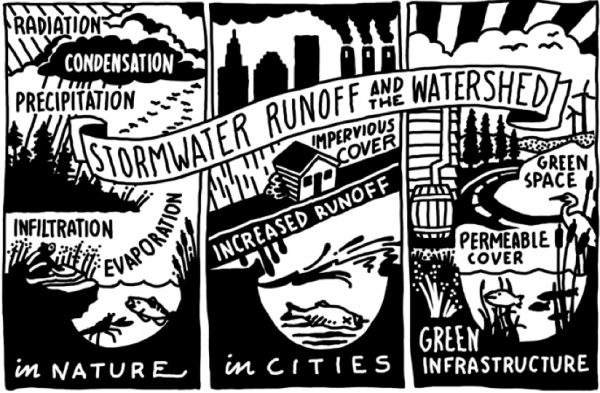
There were 41 beach closures last summer. This summer there are currently five closures – at First Beach in Middletown, the Bristol and Warren town beaches and two beaches in Tiverton. This rain event will surely lead to even more this week. (RI Future reported on the scientific causes of beach closures, their economic effects and how RI monitors the water last summer).
But the good news is while we had heavy rains last summer, we experienced fewer beach closings than previous summers. There were 86 beach closures in 2009, 55 in 2010 and 45 in 2011. The Watershed Counts report says the counter-intuitive decrease in closures can be attributed because of public investments to control stormwater runoff, sewer overflow.
“Using green infrastructure and other best management practices to protect beach water quality is paying off,” said Department of Environmental Management Director Janet Coit. “DEM welcomes the opportunity to partner with cities and towns to enhance what is a time-honored Rhode Island tradition – enjoying a glorious day at the beach.”
A clean water/open space bond on the November ballot, if approved by voters, would invest $20 million to further clean water and segregate sewage and stormwater overflow, according to the report, but that’s only a fraction of the need. “Municipalities and the Narragansett Bay Commission have identified more than $1.8 billion dollars of needed clean water in frastructure improvements ranging from wastewater treatment upgrades and storm water quality improvements to combined sewer overflow abatement projects,” according to DEM in the report.
“The opportunity to promote and invest in a beautiful Rhode Island is significant, and the need for that investment is immediate,” according to a DEM statement in the report. “Rhode Island’s greatest natural resource and a key driver to economic growth—Narragansett Bay—is threatened by polluted run-off and the damaging effects of climate change. Conversely, local food markets are booming, horticultural, and agricultural and landscape companies are doing more local business than ever, and our $2.26 billion dollar tourism sector is growing.”
According to the press release, there has been a “surprising” lack of support from the state to monitor water quality at local beaches.
“The funding for marine beach monitoring comes mostly from federal sources. The National Beach Program provided over $200,000 to both Rhode Island and Massachusetts in 2013,” it reads. “The state budgets contained no funding, despite the fact that beaches are an economic driver, and that the federal monitoring program for saltwater beaches has recently been at issue for possible elimination in federal budget talks.”
]]>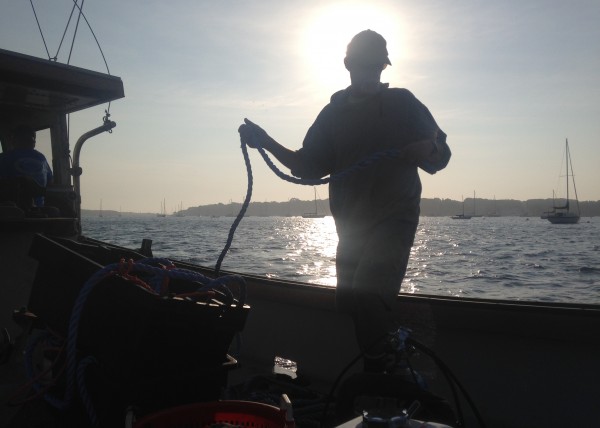
He still works the waters of the West Passage of Narragansett Bay in the Newshell, his bright red Novi (Nova Scotia-style fishing boat) often docked at Ft. Getty in Jamestown.
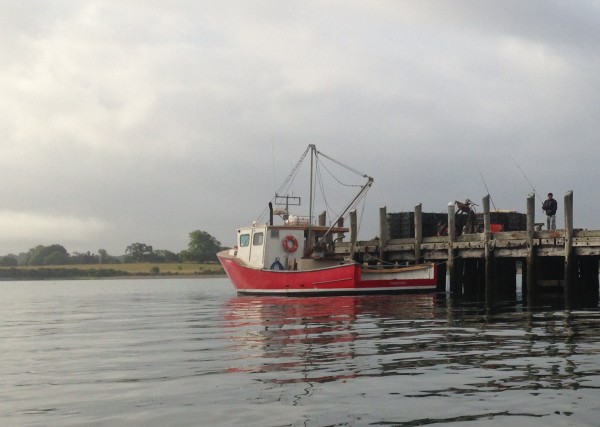 But he doesn’t look for lobster traps anymore. Now he uses the Newshell to service his oyster farm just south of the Jamestown Bridge.
But he doesn’t look for lobster traps anymore. Now he uses the Newshell to service his oyster farm just south of the Jamestown Bridge.

There are 52 oyster farms in Rhode Island spread out over 176 acres – a little more than half in Narragansett Bay (one as far north as Warwick) with the remaining 82 acres in one of four South County salt ponds.
As recently as the early 1990’s, there were no oysters in Narragansett Bay. Or not nearly enough to make any money harvesting. Then Bob “Skid” Rheault applied for an aquaculture permit with CRMC. “He was the vanguard,” explained Dale Leavitt, an aquaculture expert at Roger Williams University. “It was a three or four year permitting process.”
Since then the industry has boomed, according to state Coastal Resources Management Council data. In 2013, Rhode Island aquaculturists sold more than 6 million oysters.
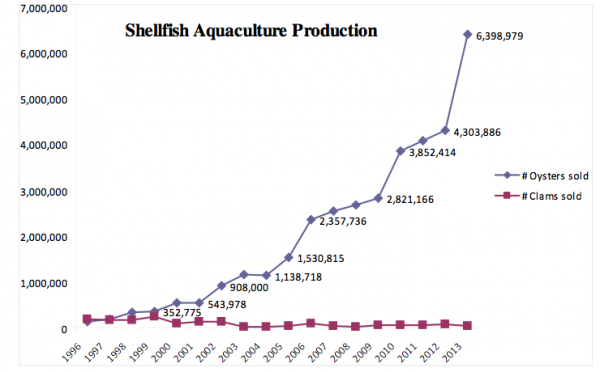
That means real money for the many restaurants, seafood stores and oyster bars that sell this delectable shellfish.”It’s providing local seafood in an era when most of our fish is imported,” said David Beutel, CRMC aquaculture coordinator. “That’s certainly valuable to us as a state.”
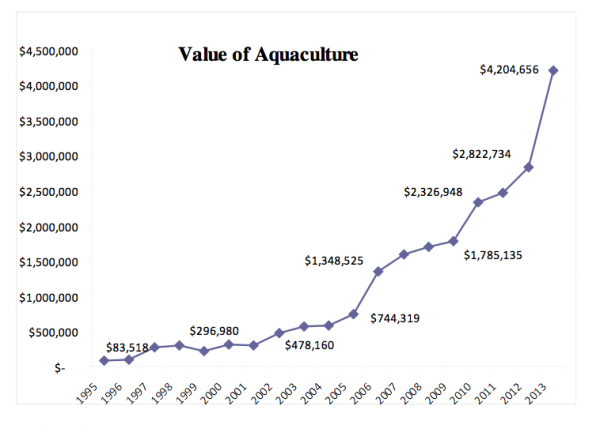
What’s more, Beutel and Leavitt both said oysters improve water quality. The shellfish filter fish-kill inducing nutrients out of Narragansett Bay. An oysters can filter 50 gallons of water daily, according to Leavitt. “They provide an important ecological service,” he said.
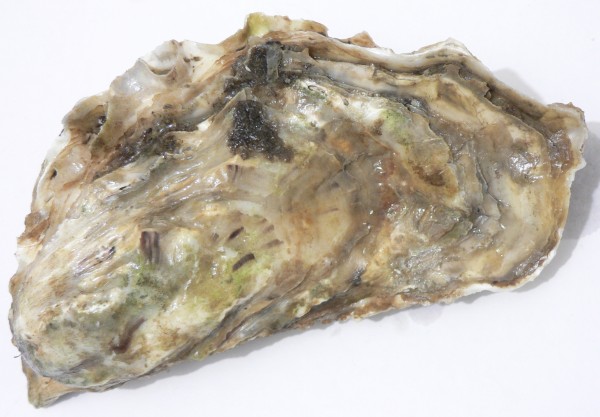
The average oyster take about 18 months to mature, said Beutel, and are then sold to local distributors who sell them here in Rhode Island and in 47 other states. Beutel said Alaska and Hawaii were on the list, and he wasn’t certain which two states were not.
They are grown in cages that typically float five or 10 feet below the surface.
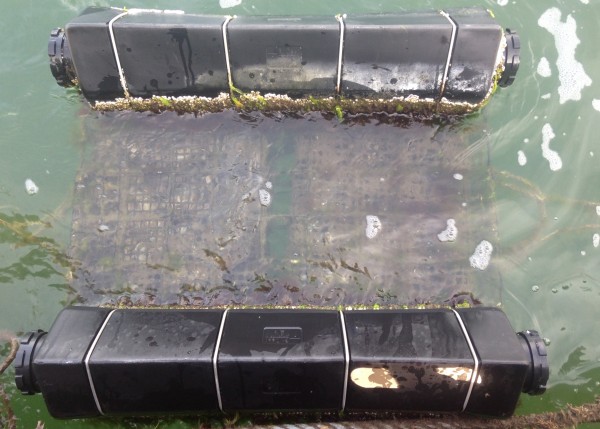
“We have an industry that creates more jobs, creates more fresh seafood and leaves the water cleaner than when it started,” said Beutel.
Goerner planted about 400,000 oyster seeds in his first two seasons. This year he’s planting another 300,000.
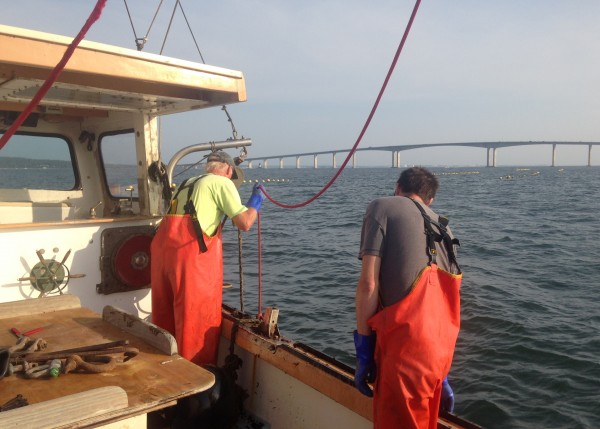
Today’s chores were an important part of that process. A 4,000 pound anchor in 30-feet-deep water had to be moved into place. This meant Sam Paterson had to go scuba diving to set the chain on the anchor.
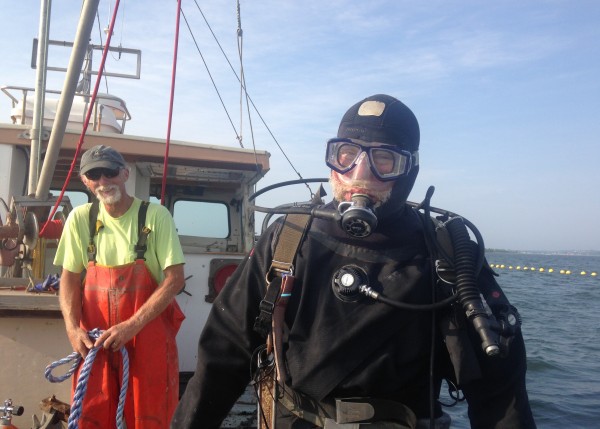
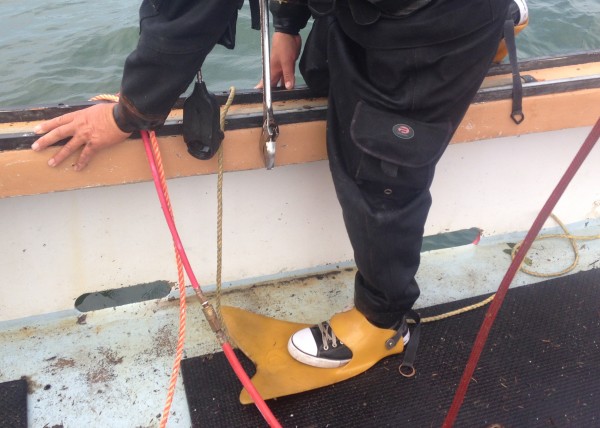
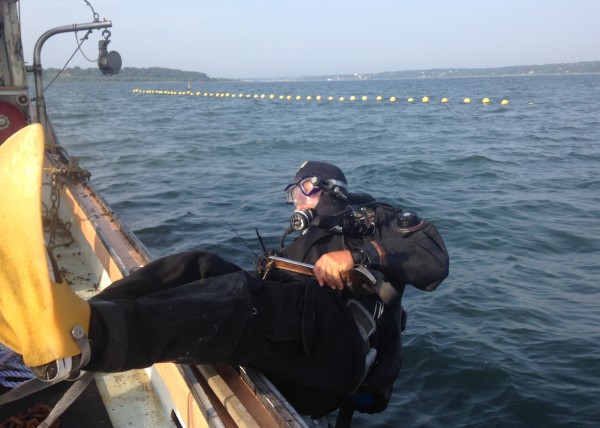
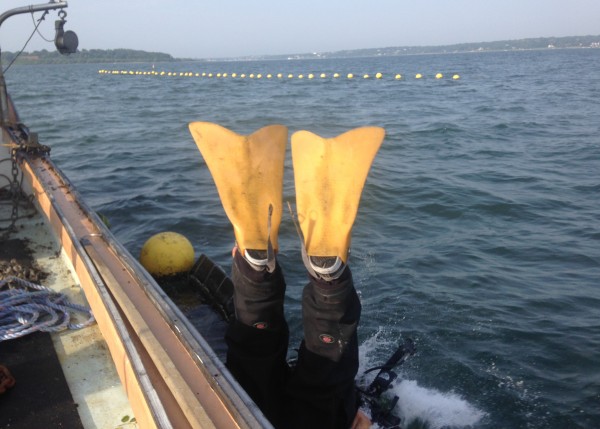
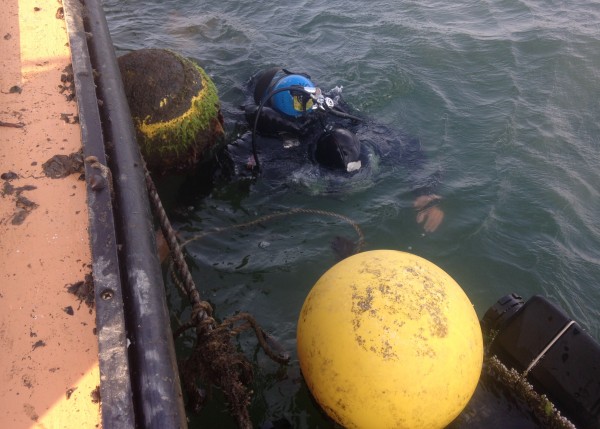 Paterson and Goerner were attaching to the 4,000 pound anchor this underwater lift bag – made by a Rhode Island company!
Paterson and Goerner were attaching to the 4,000 pound anchor this underwater lift bag – made by a Rhode Island company!
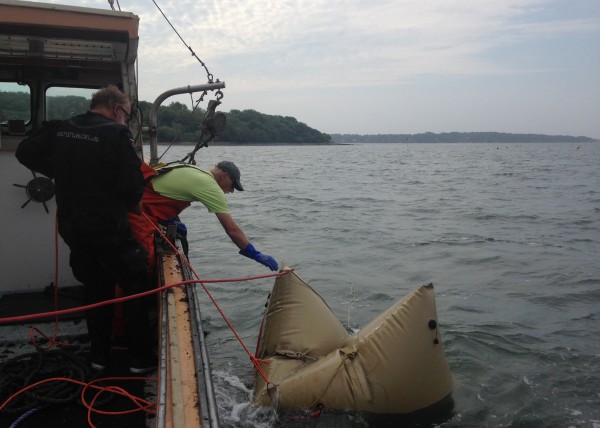
So if you enjoy these:
 Thank someone like this:
Thank someone like this:
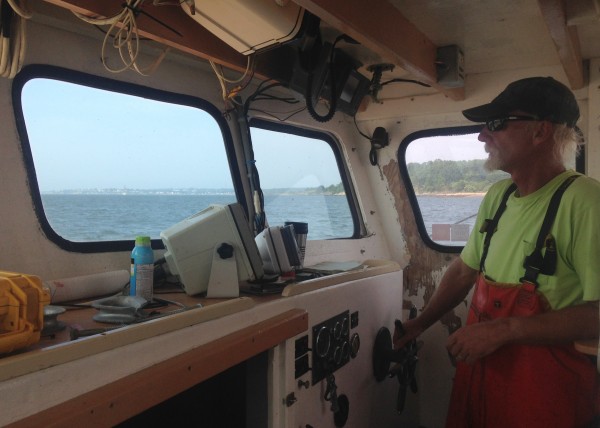
Chafee isn’t running for reelection, and doesn’t seem to regret the decision. In election years, “the boat stays ‘on the hard’ as they say,” he told me as he took me for a cruise aboard his 33-foot J100. While we sailed he said repeatedly that he’s staying focused on his final months as governor, but he mentioned maybe hiring a headhunter once he’s out of office, and said he isn’t opposed to doing something overseas. I told him he should help bring the America’s Cup back to Newport. He’s got not only the money and the name recognition, but few love the water as much as Linc Chafee.
Chafee lives in the beach community of Potowomut and his home is right next to a CRMC public right-of-way and popular neighborhood beach on Greenwich Bay, where he can often be seen paddleboarding in the early mornings. He keeps his sailboat – a bigger version of one of the most popular racing sailboats ever built, the J24 – in Dutch Harbor, the mooring field on the west side of Jamestown that can be seen when looking south from the bridge. The cove is flanked by colonial era farms and pastures, a beach or two, several salt marshes and Dutch Island. I once asked Chafee to go surfing with me, but because we agree that Dutch Harbor is just about the most beautiful place in New England, we decided to go sailing instead.
We talked a lot about the highlights of being governor. Chafee boasted of making the state more tolerant and of leading Rhode Island out of a long recession. He said he feels vindicated that the House budget suggests lowering the corporate tax and implementing combined reporting, “bold” moves he suggested in 2012. Central Falls’ recovery, he said, was his highlight as governor.
When I asked him to define his legacy in one word he said:
Several times we discussed his relationship with the media, he seems to have strong feelings about it. He made a point of saying there’s been a lack of media support for social justice issues.
Chafee’s 61 years old, and has been a city councilor, a mayor, a senator and now the governor. He wouldn’t say he was done with politics, and seemed to like the idea of perhaps running for Warwick school committee some day. He told me he may make an endorsement in the governor’s campaign, but didn’t tell me for whom. Instead of pressing him, I asked what young Linc Chafee was like.
When we got back to his mooring in Dutch Harbor, I asked him if he might be interested in buying the Providence Journal.
]]>All well and good, but it was infused with a great deal of magical thinking about keeping intact our shoreline communities with private control of access to the shore while expecting public subsidy in order to safely keep them there. There was a stunned silence after I finished my question about magical thinking, though eventually the speaker representing the real estate industry mouthed some platitudes.
In this age of austerity, in an age of shrinking livelihoods for many Americans, in an age where the rich demand that we cut their taxes and kowtow to their every whim, while they suck up all the money and insist that free enterprise is the way to the future, we need to call out the hypocrisy of the owners of the shore line when they demand that we publicly fund the infrastructure they need to maintain their houses and lifestyles and allow them to violate environmental rules and common sense, while they fund climate deniers and demand that the poor be abandoned.
The sea is coming. The issue is not how long can we hold it back for the benefit of home owners, it is how do we adapt to rising sea levels and the slow disintegration of our economy as the climate creates disaster after disaster. We can not allow rebuilding along the cost, we need to engineer a retreat while we create much larger coastal ecological buffers that will reduce our carbon footprint, and improve our food security.
Recycling the materials in coastal properties, especially the copper, before it falls into the sea is much better for all of us than waiting for the next storm. If the rich insist on waiting it out until the sea comes for them, they should pay the cost of their own stupidity and not expect the rest of us to rescue them and bail them out.
]]>